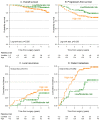Preoperative Intensified Chemoradiation with Intensity-Modulated Radiotherapy and Simultaneous Integrated Boost Combined with Capecitabine in Locally Advanced Rectal Cancer: Long-Term Outcomes of a Real-Life Multicenter Study
- PMID: 38067405
- PMCID: PMC10705284
- DOI: 10.3390/cancers15235702
Preoperative Intensified Chemoradiation with Intensity-Modulated Radiotherapy and Simultaneous Integrated Boost Combined with Capecitabine in Locally Advanced Rectal Cancer: Long-Term Outcomes of a Real-Life Multicenter Study
Abstract
Background: Despite the feasibility and promising activity data on intensity-modulated RT and simultaneous integrated boost (IMRT-SIB) dose escalation in preoperative chemoradiation (CRT) for locally advanced rectal cancer (LARC), few data are currently available on long-term outcomes.
Patients and methods: A cohort of 288 LARC patients with cT3-T4, cN0-2, cM0 treated with IMRT-SIB and capecitabine from March 2013 to December 2019, followed by a total mesorectal excision (TME) or an organ-preserving strategy, was collected from a prospective database of 10 Italian institutions. A dose of 45 Gy in 25 fractions was prescribed to the tumor and elective nodes, while the SIB dose was prescribed according to the clinical practice of each institution on the gross tumor volume (GTV). Concurrent capecitabine was administered at a dose of 825 mg/m2 twice daily, 7 days a week. The primary objective of the study was to evaluate long-term outcomes in terms of local control (LC), progression-free survival (PFS) and overall survival (OS). The secondary objective was to confirm the previously reported feasibility, safety and efficacy (pCR, TRG1-2 and downstaging rates) of the treatment in a larger patient population.
Results: All patients received a dose of 45 Gy to the tumor and elective nodes, while the SIB dose ranged from 52.5 Gy to 57.5 Gy (median 55 Gy). Acute gastrointestinal and hematologic toxicity rates of grade 3-4 were 5.7% and 1.8%, respectively. At preoperative restaging, 36 patients (12.5%) with complete or major clinical responses (cCR or mCR) were offered an organ-preserving approach with local excision (29 patients) or a watch and wait strategy (7 patients). The complete pathologic response rate (pCR) in radically operated patients was 25.8%. In addition, 4 TME patients had pT0N1 and 19 LE patients had pT0Nx, corresponding to an overall pT0 rate of 31.3%. Of the 36 patients selected for organ preservation, 7 (19.5%) required the completion of TME due to unfavorable pathologic features after LE or tumor regrowth during W-W resulting in long-term rectal preservation in 29 of 288 (10.1%) of the total patient population. Major postoperative complications occurred in 14.2% of all operated patients. At a median follow-up of 50 months, the 5-year PFS and OS rates were 72.3% (95% CI: 66.3-77.4) and 85.9% (95% CI: 80.2-90.1), respectively. The 5-year local recurrence (LR) rate was 9.2% (95% CI: 6.0-13.2), while the distant metastasis (DM) rate was 21.3% (95% CI: 16.5-26.5). The DM rate was 24.5% in the high-risk subset compared to 16.2% in the low-intermediate risk group (p = 0.062) with similar LR rates (10% and 8%, respectively). On multivariable analysis, cT4 and TRG3-5 were significantly associated with worse PFS, OS and metastasis-free survival.
Conclusions: Preoperative IMRT-SIB with the moderate dose intensification of 52.5-57.5 Gy (median 55 Gy) and the full dose of concurrent capecitabine confirmed to be feasible and effective in our real-life clinical practice. Organ preservation was shown to be feasible in carefully selected, responsive patients. The favorable long-term survival rates highlight the efficacy of this intensified treatment program. The incorporation of IMRT-SIB with a more effective systemic therapy component in high-risk patients could represent a new area of investigational interest.
Keywords: intensity modulated RT (IMRT); long-term results; preoperative chemoradiotherapy (CRT); radiotherapy dose; real-life clinical practice; rectal cancer; simultaneous integrated boost (SIB).
Conflict of interest statement
The authors declare no conflict of interest in the study.
Figures


References
-
- Maas M., Nelemans P.J., Valentini V., Das P., Rödel C., Kuo L.-J., Calvo F.A., García-Aguilar J., Glynne-Jones R., Haustermans K., et al. Long-Term Outcome in Patients with a Pathological Complete Response after Chemoradiation for Rectal Cancer: A Pooled Analysis of Individual Patient Data. Lancet Oncol. 2010;11:835–844. doi: 10.1016/S1470-2045(10)70172-8. - DOI - PubMed
-
- Capirci C., Valentini V., Cionini L., De Paoli A., Rodel C., Glynne-Jones R., Coco C., Romano M., Mantello G., Palazzi S., et al. Prognostic Value of Pathologic Complete Response after Neoadjuvant Therapy in Locally Advanced Rectal Cancer: Long-Term Analysis of 566 ypCR Patients. Int. J. Radiat. Oncol. Biol. Phys. 2008;72:99–107. doi: 10.1016/j.ijrobp.2007.12.019. - DOI - PubMed
-
- Belluco C., De Paoli A., Canzonieri V., Sigon R., Fornasarig M., Buonadonna A., Boz G., Innocente R., Perin T., Cossaro M., et al. Long-Term Outcome of Patients with Complete Pathologic Response after Neoadjuvant Chemoradiation for cT3 Rectal Cancer: Implications for Local Excision Surgical Strategies. Ann. Surg. Oncol. 2011;18:3686–3693. doi: 10.1245/s10434-011-1822-0. - DOI - PMC - PubMed
-
- Pucciarelli S., De Paoli A., Guerrieri M., La Torre G., Maretto I., De Marchi F., Mantello G., Gambacorta M.A., Canzonieri V., Nitti D., et al. Local Excision after Preoperative Chemoradiotherapy for Rectal Cancer: Results of a Multicenter Phase II Clinical Trial. Dis. Colon. Rectum. 2013;56:1349–1356. doi: 10.1097/DCR.0b013e3182a2303e. - DOI - PubMed
LinkOut - more resources
Full Text Sources
Research Materials

